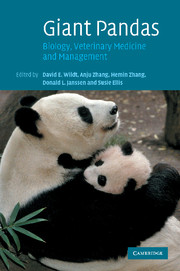Book contents
- Frontmatter
- Contents
- List of contributors
- Foreword
- Acknowledgements
- 1 The giant panda as a social, biological and conservation phenomenon
- 2 The Giant Panda Biomedical Survey: how it began and the value of people working together across cultures and disciplines
- 3 Factors limiting reproductive success in the giant panda as revealed by a Biomedical Survey
- 4 Significant medical issues and biological reference values for giant pandas from the Biomedical Survey
- 5 Life histories and behavioural traits as predictors of breeding status
- 6 Nutrition and dietary husbandry
- 7 Male reproductive biology in giant pandas in breeding programmes in China
- 8 Endocrinology of the giant panda and application of hormone technology to species management
- 9 The value and significance of vaginal cytology
- 10 Parentage assessment among captive giant pandas in China
- 11 The science of behavioural management: creating biologically relevant living environments in captivity
- 12 Evaluating stress and well-being in the giant panda: a system for monitoring
- 13 The neonatal giant panda: hand-rearing and medical management
- 14 Consequences of early rearing on socialization and social competence of the giant panda
- 15 Medical management of captive adult and geriatric giant pandas
- 16 Diseases and pathology of giant pandas
- 17 Ultrasonography to assess and enhance health and reproduction in the giant panda
- 18 Gastrointestinal endoscopy in the giant panda
- 19 Historical perspective of breeding giant pandas ex situ in China and high priorities for the future
- 20 Role and efficiency of artificial insemination and genome resource banking
- 21 Analysis of demographic and genetic trends for developing a captive breeding masterplan for the giant panda
- 22 Partnerships and capacity building for securing giant pandas ex situ and in situ: how zoos are contributing to conservation
- Index
- Plate Section
- References
7 - Male reproductive biology in giant pandas in breeding programmes in China
Published online by Cambridge University Press: 09 August 2009
- Frontmatter
- Contents
- List of contributors
- Foreword
- Acknowledgements
- 1 The giant panda as a social, biological and conservation phenomenon
- 2 The Giant Panda Biomedical Survey: how it began and the value of people working together across cultures and disciplines
- 3 Factors limiting reproductive success in the giant panda as revealed by a Biomedical Survey
- 4 Significant medical issues and biological reference values for giant pandas from the Biomedical Survey
- 5 Life histories and behavioural traits as predictors of breeding status
- 6 Nutrition and dietary husbandry
- 7 Male reproductive biology in giant pandas in breeding programmes in China
- 8 Endocrinology of the giant panda and application of hormone technology to species management
- 9 The value and significance of vaginal cytology
- 10 Parentage assessment among captive giant pandas in China
- 11 The science of behavioural management: creating biologically relevant living environments in captivity
- 12 Evaluating stress and well-being in the giant panda: a system for monitoring
- 13 The neonatal giant panda: hand-rearing and medical management
- 14 Consequences of early rearing on socialization and social competence of the giant panda
- 15 Medical management of captive adult and geriatric giant pandas
- 16 Diseases and pathology of giant pandas
- 17 Ultrasonography to assess and enhance health and reproduction in the giant panda
- 18 Gastrointestinal endoscopy in the giant panda
- 19 Historical perspective of breeding giant pandas ex situ in China and high priorities for the future
- 20 Role and efficiency of artificial insemination and genome resource banking
- 21 Analysis of demographic and genetic trends for developing a captive breeding masterplan for the giant panda
- 22 Partnerships and capacity building for securing giant pandas ex situ and in situ: how zoos are contributing to conservation
- Index
- Plate Section
- References
Summary
INTRODUCTION
The goal of the giant panda ex situ breeding programme is to produce healthy, genetically diverse and reproductively sound offspring. However, reproduction in this species has been poor, in part, due to lack of male libido or aggressive behaviours towards conspecific females. Although giant panda breeding facilities have made progress in producing more surviving young, only about 29% of captive male giant pandas have ever sired offspring (Lindburg et al., 1998), and most of these males were wild born. Of the 104 giant pandas in the ex situ population in China in 1996 (at the time of the first masterplanning meeting in China; Zheng et al., 1997; see also Chapter 2), there were 33 adult males of reproductive age (6–26 years old). Only five (15.2%) had ever mated naturally and sired young. This was the main reason for ‘male reproduction’ being a primary target of the Biomedical Survey conducted under the umbrella of the Conservation Breeding Specialist Group (CBSG) (see Chapter 2).
We had three goals, the first being to measure the presence or absence of any obvious physiological or anatomical abnormalities. The second was to learn more about species reproductive biology, specifically comparing males of different ages, successful versus unsuccessful breeders and wild-born versus captive born. Our approach also allowed a third opportunity: studies that would enhance our understanding on how better to use male gametes (sperm) to advance genetic management (see Chapter 21). In this case, our focus was on:
sperm morphology and acrosomal integrity;
testes development during the breeding season;
[…]
- Type
- Chapter
- Information
- Giant PandasBiology, Veterinary Medicine and Management, pp. 159 - 197Publisher: Cambridge University PressPrint publication year: 2006
References
- 5
- Cited by

